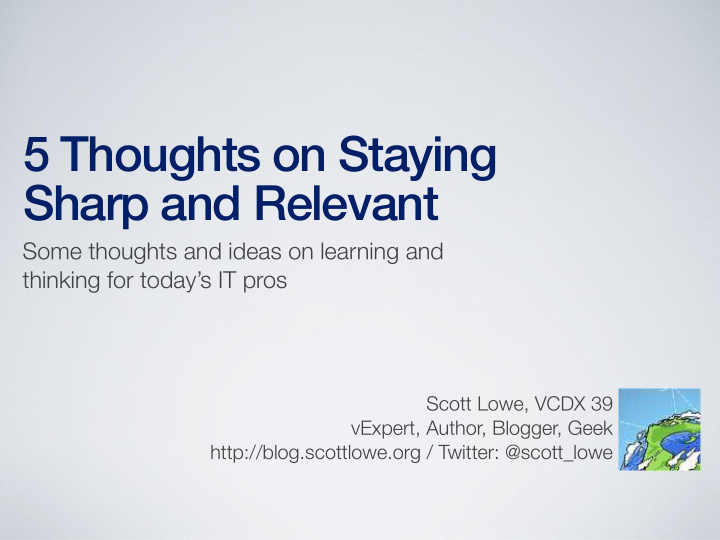



5 Thoughts on Staying Sharp and Relevant Some thoughts and ideas on learning and thinking for today’s IT pros Scott Lowe, VCDX 39 vExpert, Author, Blogger, Geek http://blog.scottlowe.org / Twitter: @scott_lowe
Before we start • Get involved! Audience participation is encouraged and requested. • If you use Twitter, feel free to tweet about this session (use @UKVMUG or hashtag #UKVMUG) • I encourage you to take photos or videos of today’s session and share them online • This presentation will be made available online after the event
Agenda • Two thoughts or ideas about learning • Three things I think are worth learning • 2 + 3 = 5
“Man’s mind, once stretched by a new idea, never regains its original dimensions.” - Oliver Wendell Holmes, 1809-1894
Two thoughts or ideas about learning • Metacognition: it’s useful to think about thinking (specifically with regard to how we learn) • Rapid pace of change within IT means that we are under constant pressure to learn • I’d like to share two thoughts or ideas on the learning process • First, an approach to assimilating new information • Second, some tools for managing information
“An VNI terminated on an NVE may locally associate to one or more VAPs each of which may associated with one or more TESs.” - Taken from IETF document draft-mity-nvo3-use-case-00.txt
“Storage connectivity using Fibre Channel, iSCSI, SVD, and FCoE is supported with VMware vMSC configurations.” - Taken from VMware vSphere Metro Storage Cluster Case Study
Assimilating new information • In education, there’s a “classical education” approach • Classical education has three major phases: • Grammar: focuses on facts, mechanics, vocabulary • Logic: focuses on the reasons behind the facts • Rhetoric: focuses on drawing conclusions, presenting information to others • Classical education is often repetitive, each iteration more in- depth than the previous
Assimilating new information (continued) • How can we, as IT pros, apply this to our situation? • When learning a new product or technology, first define the terminology. (grammar) • Once you’ve learned the vocabulary, then move to a deeper understanding of how it works. (logic) • After you understand how it works, find the relationships and connect it to something you already know. (rhetoric) • Lather, rinse, repeat!
Managing information • In 2008, I came across a web page that discussed something called “Q-tools” • You can find the original article at http:// www.davegrayinfo.com/2008/06/04/q-tools/ • These are a set of proposed tools (questions) to help people manage information
Managing information (continued) • Prism: used to break information down into subgroups • Razor: used to divide information or for binary sorting • Generator: used to explore new territory or new ideas • Peeler: used to drive deeper and deeper into a subject • Flanker: used for lateral thinking and explore similar ideas • Splicer: used to build information structures by finding similarities • Pointer: used to gather information
Managing information (continued) • How can we, as IT pros, apply these tools to our situation? • You’re trying to learn a complex new technology with many different parts. (Prism: break it down) • You’re stuck on a problem and can’t seem to make headway. (Flanker: think laterally, or generator: new ideas) • You want to gain a better understanding of a particular solution. (Peeler: go deeper) • You want to link something you've learned back to existing knowledge. (Splicer: find similarities)
Three things to learn • Linux • Automation • PowerCLI, vCenter Orchestrator, scripting languages • Automation is a lever that multiplies your force • Configuration management • Think Puppet, Chef, or CFEngine • Your servers should not be snowflake servers! • See http://martinfowler.com/bliki/SnowflakeServer.html
Questions & Answers
Thank you! Don’t forget to provide feedback and rate this session on the last page of your Program Guide.
Recommend
More recommend